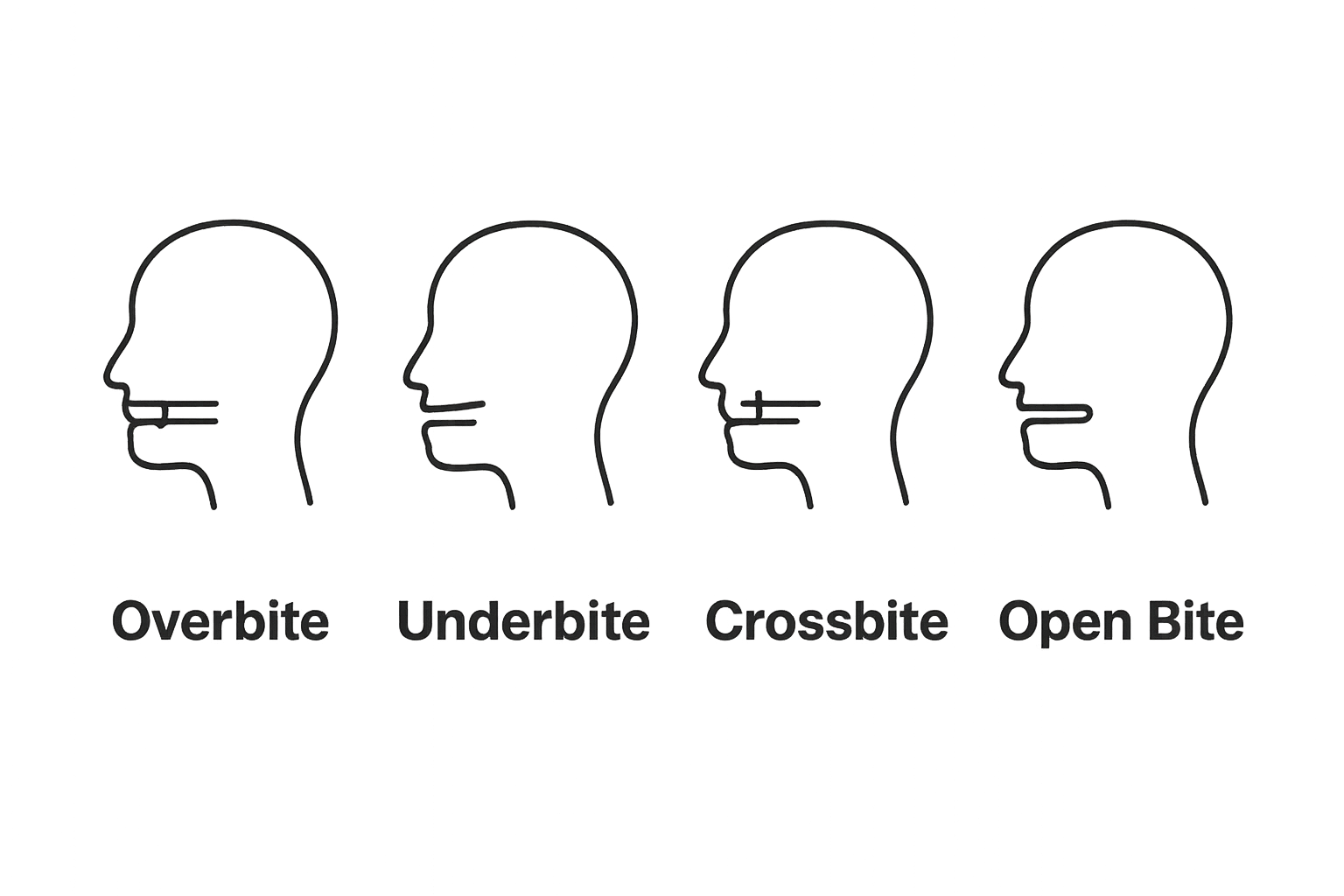Understanding Jaw Alignment Problems: What You Need to Know
September 10, 2025
Understanding Jaw Alignment Problems: What You Need to Know
Jaw alignment problems touch more lives than most people imagine. Almost 20 percent of the population deals with some form of malocclusion that can impact chewing, speech, and even self-confidence. You might think these issues are just about crooked teeth or how your smile looks. The bigger shock is that jaw misalignment can quietly trigger chronic pain, headaches, and even social anxiety if left untreated.
Table of Contents
- What Are Jaw Alignment Problems And Their Types?
- Why Jaw Alignment Matters For Oral Health And Well-Being
- How Jaw Alignment Issues Develop And Affect Daily Life
- Key Concepts In Treating Jaw Alignment Problems
- Exploring Treatment Options For Jaw Alignment Issues
Quick Summary
| Takeaway | Explanation |
|---|---|
| Jaw alignment problems impact overall health. | Misalignment can lead to pain, speech issues, and dental complications. Addressing these is crucial for well-being. |
| Early intervention is key for better outcomes. | Identifying alignment issues early can prevent long-term health problems and improve treatment success. |
| Multiple treatment options are available. | Treatment ranges from braces and aligners to surgical methods, tailored to individual needs and misalignment severity. |
| Jaw misalignment affects daily activities. | Challenges in eating, speaking, and socializing can stem from misalignment, affecting quality of life. |
| Psychological effects can be significant. | Individuals with noticeable misalignments may experience lowered self-esteem and social anxiety, impacting personal interactions. |
What are Jaw Alignment Problems and Their Types?
Jaw alignment problems, also known as malocclusion, represent complex dental and skeletal issues that affect how upper and lower teeth connect and interact. These conditions can significantly impact an individual’s oral health, facial aesthetics, and overall quality of life.
Understanding Jaw Misalignment
Jaw alignment problems occur when teeth do not fit together correctly, creating potential functional and structural challenges. Mayo Clinic explains that these misalignments can result from various factors including genetic predisposition, childhood habits, or developmental irregularities.
The primary types of jaw alignment problems include:

- Overbite: When upper front teeth significantly overlap lower front teeth
- Underbite: When lower teeth extend beyond upper teeth
- Crossbite: When some upper teeth sit inside lower teeth when biting
- Open Bite: When front teeth do not touch when mouth is closed
Potential Consequences of Untreated Jaw Misalignment
Ignoring jaw alignment problems can lead to numerous health complications. Misaligned jaws can cause chronic pain, difficulty chewing, speech impediments, and accelerated tooth wear. Uneven dental pressure can also trigger temporomandibular joint disorders (TMJ), which may result in persistent jaw pain and headaches.
Professional orthodontic assessment remains crucial for identifying and addressing these intricate dental structural issues. Early detection and intervention can prevent long-term complications and support optimal oral health and functionality.
To clarify the main types of jaw alignment problems discussed in this article, the following table summarizes their core characteristics and effects.
| Jaw Alignment Problem | Description | Common Impact |
|---|---|---|
| Overbite | Upper front teeth significantly overlap lower front teeth | May cause excessive wear on lower teeth, jaw discomfort |
| Underbite | Lower teeth extend beyond upper teeth | May impact chewing, speech clarity, facial aesthetics |
| Crossbite | Some upper teeth sit inside lower teeth when biting | May cause uneven tooth wear, gum problems |
| Open Bite | Front teeth do not touch when mouth is closed | May lead to difficulties biting food, speech issues |
Why Jaw Alignment Matters for Oral Health and Well-Being
Jaw alignment extends far beyond cosmetic concerns, playing a critical role in overall oral health, functional performance, and personal wellness. Proper dental alignment impacts everything from basic physiological functions to long-term health outcomes.
The Functional Significance of Proper Jaw Alignment
Proper jaw alignment enables fundamental human activities like eating, speaking, and breathing. When teeth and jaw structures are correctly positioned, individuals experience optimal oral mechanics. National Library of Medicine research indicates that misalignment can lead to significant functional challenges, including:
- Inefficient chewing and food processing
- Compromised speech articulation
- Increased risk of periodontal disease
- Higher likelihood of temporomandibular joint disorders
Long-Term Health Implications
Untreated jaw alignment problems can trigger cascading health complications. Misaligned teeth create uneven pressure distribution, potentially causing accelerated tooth wear, chronic jaw pain, and increased susceptibility to dental infections. Improper bite mechanics strain facial muscles and joints, potentially leading to headaches, neck pain, and reduced overall quality of life.
Moreover, jaw alignment problems can impact psychological well-being. Individuals with noticeable dental misalignments might experience reduced self-confidence, social anxiety, and communication hesitancy. Addressing these issues through professional orthodontic intervention can restore not just dental function, but personal comfort and social interactions.
How Jaw Alignment Issues Develop and Affect Daily Life
Jaw alignment issues emerge through a complex interplay of genetic, developmental, and environmental factors. Understanding their origins helps individuals recognize potential risks and seek timely professional intervention.
Root Causes of Jaw Misalignment
National Institutes of Health research indicates that jaw alignment problems can originate from multiple sources. Genetic predisposition plays a significant role, with inherited traits determining jaw structure and potential misalignment. Additionally, early childhood behaviors contribute substantially to developmental challenges:
- Prolonged thumb-sucking
- Extended pacifier use
- Mouth breathing patterns
- Early loss of baby teeth
- Traumatic dental injuries
Impact on Daily Functional Experiences
Jaw alignment problems extend beyond physical discomfort, profoundly affecting an individual’s daily interactions and personal experiences. Misaligned jaws can create subtle yet significant challenges in routine activities. Communication becomes more difficult, with potential speech impediments emerging. Eating transforms from a simple necessity to a complex, sometimes painful experience.
Psychological implications are equally important. Individuals with noticeable jaw misalignments might experience reduced self-confidence, social anxiety, and hesitation in public speaking or social interactions. The cumulative effect can create a cycle of decreased social engagement and emotional strain.

Professional orthodontic assessment remains crucial in identifying, understanding, and addressing these intricate developmental challenges. Early recognition and intervention can mitigate long-term functional and psychological impacts, supporting both physical health and personal well-being.
Key Concepts in Treating Jaw Alignment Problems
Treating jaw alignment problems requires a comprehensive, personalized approach that considers individual anatomical characteristics, developmental history, and specific functional challenges. Successful intervention demands precision, expertise, and a nuanced understanding of oral structural dynamics.
Diagnostic Assessment and Treatment Planning
National Institutes of Health research highlights that effective jaw alignment treatment begins with thorough diagnostic evaluation. Orthodontic professionals employ advanced diagnostic tools to comprehensively assess jaw structure, tooth positioning, and potential functional limitations:
- Detailed 3D imaging techniques
- Comprehensive dental and skeletal analysis
- Evaluation of bite mechanics and jaw movement
- Assessment of potential functional impairments
- Review of patient’s medical and developmental history
Treatment Modalities and Intervention Strategies
Treatment for jaw alignment problems varies based on individual needs and complexity. Orthodontic interventions range from conservative approaches to more extensive surgical procedures. The primary treatment strategies include:
- Orthodontic Braces: Gradually repositioning teeth and supporting jaw realignment
- Clear Aligners: Providing discreet, removable correction mechanisms
- Jaw Repositioning Devices: Helping guide proper jaw growth and alignment
- Surgical Interventions: Addressing severe structural misalignments
The ultimate goal of jaw alignment treatment extends beyond cosmetic improvement. Professionals aim to restore functional oral mechanics, prevent potential long-term health complications, and support overall physiological well-being. Personalized treatment plans consider not just immediate correction but also long-term stability and patient comfort.
Exploring Treatment Options for Jaw Alignment Issues
Addressing jaw alignment problems requires a multifaceted approach that considers individual patient needs, the complexity of misalignment, and potential long-term health implications. Treatment strategies range from conservative interventions to more comprehensive surgical approaches.
Conservative Treatment Approaches
Mayo Clinic highlights several non-invasive strategies for managing jaw alignment challenges. Conservative treatments focus on alleviating symptoms and promoting gradual structural improvements:
- Physical therapy techniques
- Specialized oral splints and mouth guards
- Targeted pain management medications
- Stress reduction and relaxation techniques
- Gentle jaw exercises and muscle conditioning
Advanced Intervention Strategies
For more complex jaw alignment issues, advanced treatment options become necessary. These interventions address structural misalignments that cannot be resolved through conservative methods. Potential advanced treatments include:
- Orthodontic Braces: Systematically repositioning teeth and supporting jaw realignment
- Surgical Jaw Repositioning: Correcting fundamental skeletal discrepancies
- Arthroscopic Procedures: Minimally invasive techniques for joint assessment and repair
- Comprehensive Reconstructive Interventions: Addressing severe structural abnormalities
The selection of treatment depends on multiple factors, including the patient’s age, severity of misalignment, underlying medical conditions, and potential functional limitations. Orthodontic professionals develop personalized treatment plans that balance immediate correction with long-term oral health objectives.
The following table provides an overview of conservative and advanced treatment options mentioned in the article, organizing them by approach and typical applications.
| Treatment Approach | Example Treatments | When Used |
|---|---|---|
| Conservative | Physical therapy, oral splints/mouth guards, pain medication, stress reduction, jaw exercises | For mild to moderate misalignment or symptom management |
| Advanced | Orthodontic braces, surgical jaw repositioning, arthroscopic procedures, reconstructive interventions | For severe structural issues or when conservative methods are insufficient |
Ready to Transform Your Smile and Jaw Health?
If you are struggling with jaw alignment problems like overbite, underbite, crossbite, or open bite, you know how much these issues can affect your daily comfort, confidence, and quality of life. Misaligned jaws can cause pain, difficulty eating, and even impact your speech. At Glow Orthodontics, we understand how important proper jaw alignment is for both your oral health and overall well-being.

Take control of your oral health and invest in your future with the personalized solutions available at Glow Orthodontics. Our friendly team specializes in advanced orthodontic treatments and Invisalign specifically designed to address complex jaw alignment problems. Explore how our treatment process can help you achieve a balanced, pain-free smile. Book your consultation today and start your journey toward lasting comfort and renewed confidence.
Frequently Asked Questions
What are the common types of jaw alignment problems?
Jaw alignment problems, or malocclusion, typically include overbite, underbite, crossbite, and open bite.
How can misaligned jaws affect daily life?
Misaligned jaws can lead to difficulties in eating and speaking, chronic pain, and reduced self-confidence and social engagement due to noticeable dental issues.
What are some treatment options for jaw alignment issues?
Treatment options for jaw alignment problems include orthodontic braces, clear aligners, jaw repositioning devices, and in severe cases, surgical interventions.
Why is early intervention important for jaw alignment problems?
Early intervention can prevent long-term functional and health complications, restore optimal oral mechanics, and enhance overall quality of life.